#stackpath edge compute
Explore tagged Tumblr posts
Text
Edge Data Center Market Size, Share, Analysis, Forecast, and Growth Trends to 2032: North America and Asia-Pacific Lead the Race
Edge Data Center Market was valued at USD 10.82 billion in 2023 and is expected to reach USD 57.39 billion by 2032, growing at a CAGR of 20.39% from 2024-2032.
The Edge Data Center Market is rapidly evolving as demand surges for faster data processing and reduced latency. With the rise of technologies like IoT, 5G, AI, and smart devices, businesses and service providers are turning to decentralized computing infrastructure. These smaller, strategically located data centers are being deployed closer to end users and devices, enabling real-time data handling and reducing reliance on centralized cloud systems.
Edge data center market transforming the digital landscape by supporting bandwidth-heavy applications and minimizing latency. They are proving essential for sectors such as healthcare, manufacturing, retail, and telecommunications, where immediate data processing is crucial. As enterprises embrace digital transformation, edge computing becomes a core element in network strategies worldwide.
Get Sample Copy of This Report: https://www.snsinsider.com/sample-request/3982
Market Keyplayers:
Amazon Web Services (AWS) –( Dell Technologies, Cisco Systems)
Microsoft Azure – (Hewlett Packard Enterprise (HPE), Lenovo)
Google Cloud – (NVIDIA, Cisco Systems)
IBM – (NetApp, Lenovo)
Cisco Systems – (Arista Networks, Dell Technologies)
EdgeConneX – (Schneider Electric, Vertiv)
Equinix – (Nokia, Corning)
Digital Realty – (Fujitsu, Siemens)
Alibaba Cloud – (Huawei Technologies, Inspur)
Hewlett Packard Enterprise (HPE) – (Arista Networks, Dell Technologies)
Vertiv – (Schneider Electric, Eaton)
Fujitsu – (NEC Corporation, Hitachi)
Huawei Technologies – (ZTE Corporation, Inspur)
NTT Communications – (Cisco Systems, Juniper Networks)
Oracle – (Dell Technologies, NetApp)
Vantage Data Centers – (Vertiv, Schneider Electric)
CyrusOne – ((Cisco Systems, Dell Technologies)
Glesys – (DigitalOcean, Linode)
Iron Mountain – (Vertiv, Schneider Electric)
StackPath – (Akamai Technologies, CenturyLink)
Market Analysis The edge data center market is experiencing unprecedented growth due to the exponential rise in data generation. Traditional data center models are struggling to meet the low-latency requirements of next-gen applications. This shift is fueling investments in edge infrastructure globally, particularly in urban areas and remote locations where real-time data processing is vital. Additionally, enterprises are leveraging edge solutions to enhance operational efficiency, data sovereignty, and compliance with regional data regulations. Strategic partnerships, mergers, and innovations are shaping the competitive landscape, pushing both established and emerging players to optimize performance and scalability at the edge.
Market Trends
Rise in adoption of 5G and IoT driving need for localized data processing
Growing use of AI and machine learning at the edge
Deployment of micro data centers in underserved areas
Increased focus on sustainability and energy efficiency
Integration with hybrid and multi-cloud strategies
Advancements in edge security and data protection
Market Scope
Scalable Infrastructure: Flexible deployments enabling customized and modular data center solutions
Vertical Expansion: Strong adoption across sectors including healthcare, manufacturing, finance, and automotive
Global Reach: Accelerating deployment in both developed and emerging economies
Smart Urbanization: Smart city initiatives fueling edge installations for traffic management, surveillance, and utilities
Edge-to-Cloud Synergy: Seamless data flow from edge to centralized cloud for hybrid operations
Edge computing is not confined to tech giants—it's empowering SMEs, rural industries, and local governments to become part of a larger, faster digital ecosystem. The scope of edge data centers is not only technological but also socio-economic, bridging the gap between rural connectivity and urban innovation.
Access Complete Report: https://www.snsinsider.com/reports/edge-data-center-market-3982
Market Forecast The future of the Edge Data Center Market is marked by dynamic innovation and strategic expansion. As businesses become increasingly data-driven, the demand for real-time analytics, autonomous systems, and responsive digital services will intensify. Edge infrastructure will evolve to handle complex workloads while supporting ultra-reliable communication networks. The market is poised for transformative growth, with disruptive technologies and collaborative ecosystems playing a pivotal role. Investment in edge deployments will not only enhance user experience but also unlock new business models and revenue streams across industries.
Conclusion The Edge Data Center Market represents more than just a trend—it’s a paradigm shift in how data is processed, stored, and delivered. With its potential to empower industries, transform infrastructure, and enable real-time intelligence, edge computing is reshaping the digital frontier. Enterprises that embrace this shift early stand to gain a competitive edge, unlocking speed, security, and scalability. As the world moves closer to a hyperconnected future, edge data centers are set to be the cornerstones of next-gen digital transformation.
About Us:
SNS Insider is one of the leading market research and consulting agencies that dominates the market research industry globally. Our company's aim is to give clients the knowledge they require in order to function in changing circumstances. In order to give you current, accurate market data, consumer insights, and opinions so that you can make decisions with confidence, we employ a variety of techniques, including surveys, video talks, and focus groups around the world.
Contact Us:
Jagney Dave - Vice President of Client Engagement
Phone: +1-315 636 4242 (US) | +44- 20 3290 5010 (UK)
#Edge Data Center Market#Edge Data Center Market Scope#Edge Data Center Market Share#Edge Data Center Market Trends
0 notes
Text
What's the fastest Content Delivery Network (CDN)?
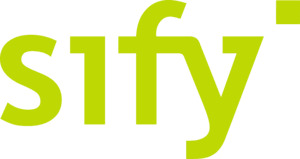
Determining the fastest Content Delivery Network (CDN) can be subjective and depends on various factors such as geographical location, network infrastructure, website optimization, and the specific content being delivered. However, several CDNs are renowned for their speed and reliability. Here are some of the top contenders:
Akamai: Akamai is one of the oldest and most established CDNs, with a vast global network of servers strategically distributed around the world. It offers advanced caching, acceleration, and security features, making it a popular choice for delivering high-performance content.
Cloudflare: Cloudflare operates one of the largest CDN networks globally, known for its robust performance and security features. It utilizes advanced technologies such as Anycast routing and edge computing to optimize content delivery and minimize latency.
Amazon CloudFront: Part of Amazon Web Services (AWS), CloudFront is a highly scalable CDN that integrates seamlessly with other AWS services. It offers low latency and high transfer speeds by leveraging Amazon's extensive global infrastructure.
Fastly: Fastly is a CDN designed for high-performance content delivery, particularly suited for delivering dynamic content and streaming media. Its edge cloud platform is known for its real-time caching and instant purging capabilities, resulting in fast and reliable content delivery.
CDN77: CDN77 is a global CDN provider known for its high-performance content delivery and competitive pricing. It offers a wide range of features, including HTTP/2 support, GZIP compression, and real-time analytics, making it a popular choice for businesses of all sizes.
Limelight Networks: Limelight Networks operates a global CDN optimized for delivering digital content, live and on-demand video streaming, and large file downloads. It boasts a high-performance infrastructure with extensive reach and low latency.
StackPath: StackPath offers a secure CDN with advanced caching and acceleration capabilities. It provides a user-friendly interface and flexible pricing options, making it suitable for businesses seeking reliable content delivery solutions.
It's essential to evaluate CDN performance based on your specific requirements, including geographic reach, traffic volume, content type, and budget constraints. Additionally, conducting performance tests and benchmarking different CDNs in your target regions can help determine which CDN offers the best speed and reliability for your website or application.
0 notes
Text
Stackpath CDN review | pros/cons, alternative, competitors
Stackpath CDN review | pros/cons, alternative, competitors
Website performance can make or break businesses in today’s scenario. CDN has potential to insanely speeding up your website & boost all key parameters, which matters alot. Stackpath CDN has grown big in previous two years, and largely credit goes to its uniquely built platform which leveraged the strengths of leading market players and integrated them into one unified cloud based most secured…
View On WordPress
#how to setup stackpath cdn#how to use stackpath cdn#stackpath cdn#stackpath cdn review#stackpath cdn setup#stackpath cdn wordpress#stackpath dns#stackpath edge compute#stackpath full site integration#stackpath maxcdn#stackpath review#stackpath vpn#stackpath vs cloudflare#stackpath vs maxcdn#stackpath vs sucuri#stackpath wordpress
0 notes
Text
Research Details Developments In The Edge Computing Management Software Market Analysis And Forecast To 2028 | AWS, IBM, Rancher
The recent research report on the Global Edge Computing Management Software Market 2022-2028 explains current market trends, possible growth rate, differentiable industry strategies, future prospects, significant players and their profiles, regional analysis, and industry shares as well as forecast details. The detail study offers a wide range of considerable information that also highlights the importance of the foremost parameters of the world Edge Computing Management Software market.
Market Is Expected to Reach Rise At A CAGR Of 38% During The Forecast Period
(Exclusive Offer: Flat 30% discount on this report)
Click Here to Get Free Sample PDF Copy of Latest Research on Edge Computing Management Software Market 2022 Before Purchase:
https://www.theresearchinsights.com/request_sample.php?id=489246&mode=V004
Top Key Players are covered in this report:
AWS, IBM, Rancher, Akamai, Check Point, NETSCOUT, Bosch, ClearBlade, Crosser, EdgeIQ, Google, Bright Computing, Software AG, StackPath, FogHorn, SAS, Nutanix
On the Basis of Product, the Edge Computing Management Software Market Is Primarily Split Into
· Cloud-based
· On-premises
On the Basis of End Users/Application, This Report Covers
· Large Enterprises
· SMEs
·
The regions are further sub-divided into:
-North America (NA) – US, Canada, and Mexico
-Europe (EU) – UK, Germany, France, Italy, Russia, Spain & Rest of Europe
-Asia-Pacific (APAC) – China, India, Japan, South Korea, Australia & Rest of APAC
-Latin America (LA) – Brazil, Argentina, Peru, Chile & Rest of Latin America
-The Middle East and Africa (MEA) – Saudi Arabia, UAE, Israel, South Africa
Major Highlights of the Edge Computing Management Software Market report study:
· A detailed look at the global Edge Computing Management Software Industry
· The report analyzes the global Edge Computing Management Software market and provides its stakeholders with significant actionable insights
· The report has considered all the major developments in the recent past, helping the users of the report with recent industry updates
· The report study is expected to help the key decision-makers in the industry to assist them in the decision-making process
· The study includes data on Edge Computing Management Software market intelligence, changing market dynamics, current and expected market trends, etc.
· The report comprises an in-depth analysis of macroeconomic and microeconomic factors affecting the global Edge Computing Management Software market
· Market Ecosystem and adoption across market regions
· Major trends shaping the global Edge Computing Management Software market
· Historical and forecast size of the Edge Computing Management Software market in terms of Revenue (USD Million)
SPECIAL OFFER: AVAIL UP TO 30% DISCOUNT ON THIS REPORT:
https://www.theresearchinsights.com/ask_for_discount.php?id=489246&mode=V004
Market Segment Analysis:
The Edge Computing Management Software Report provides a primary review of the industry along with definitions, classifications, and enterprise chain shape. Market analysis is furnished for the worldwide markets which include improvement tendencies, hostile view evaluation, and key regions development. Development policies and plans are discussed in addition to manufacturing strategies and fee systems are also analyzed. This file additionally states import/export consumption, supply and demand, charge, sales and gross margins.
Browse Full Report at:
https://www.theresearchinsights.com/reports/global-edge-computing-management-software-market-growth-2022-2028-489246?mode=V004
The Research covers the following objectives:
– To study and analyze the Global Edge Computing Management Software consumption by key regions/countries, product type and application, history data from 2016 to 2022, and forecast to 2026.
– To understand the structure of Edge Computing Management Software by identifying its various sub-segments.
– Focuses on the key global Edge Computing Management Software manufacturers, to define, describe and analyze the sales volume, value, market share, market competition landscape, Porter’s five forces analysis, SWOT analysis and development plans in the next few years.
– To analyze the Edge Computing Management Software with respect to individual growth trends, future prospects, and their contribution to the total market.
– To share detailed information about the key factors influencing the growth of the market (growth potential, opportunities, drivers, industry-specific challenges and risks).
– To project the consumption of Edge Computing Management Software submarkets, with respect to key regions (along with their respective key countries).
Report Customization:
Edge Computing Management Software, the report can be customized according to your business requirements as we recognize what our clients want, we have extended 25% customization at no additional cost to all our clients for any of our syndicated reports.
In addition to customization of our reports, we also offer fully tailored research solutions to our clients in all industries we track.
Our research and insights help our clients in identifying compatible business partners.
Note: All of the reports that we list have been tracking the impact of COVID-19 on the market. In doing this, both the upstream and downstream flow of the entire supply chain has been taken into account. In addition, where possible we will provide an additional COVID-19 update report/supplement to the report in Q3, please check with the sales team.
About us:
The Research Insights – A world leader in analysis, research and consulting that can help you renew your business and change your approach. With us you will learn to make decisions with fearlessness. We make sense of inconveniences, opportunities, circumstances, estimates and information using our experienced skills and verified methodologies. Our research reports will provide you with an exceptional experience of innovative solutions and results. We have effectively led companies around the world with our market research reports and are in an excellent position to lead digital transformations. Therefore, we create greater value for clients by presenting advanced opportunities in the global market.
Contact Us:
Robin
Sales Manager
Contact number: + 91-996-067-0000
https://www.theresearchinsights.com
0 notes
Text
Global DDoS Protection and Mitigation Market Analysis, Historic Data and forecast 2017-2022
Summary – A new market study, titled "Global DDoS Protection and Mitigation Market Size, Status and Forecast 2020-2026" has been featured on WiseGuyReports.
A distributed denial-of-service (DDoS) attack is an attack in which multiple compromised computer systems attack a target, such as a server, website or other network resource, and cause a denial of service for users of the targeted resource. The flood of incoming messages, connection requests or malformed packets to the target system forces it to slow down or even crash and shut down, thereby denying service to legitimate users or systems.
DDoS attacks have been carried out by diverse threat actors, ranging from individual criminal hackers to organized crime rings and government agencies. In certain situations, often ones related to poor coding, missing patches or generally unstable systems, even legitimate requests to target systems can result in DDoS-like results.
Also read – https://wiseguyreports.wordpress.com/2020/07/30/impact-of-covid-19-outbreak-on-ddos-protection-and-mitigation-market-2020-2/
Since the COVID-19 virus outbreak in December 2019, the disease has spread to almost 100 countries around the globe with the World Health Organization declaring it a public health emergency. The global impacts of the coronavirus disease 2019 (COVID-19) are already starting to be felt, and will significantly affect the DDoS Protection and Mitigation market in 2020.
COVID-19 can affect the global economy in three main ways: by directly affecting production and demand, by creating supply chain and market disruption, and by its financial impact on firms and financial markets.
The outbreak of COVID-19 has brought effects on many aspects, like flight cancellations; travel bans and quarantines; restaurants closed; all indoor events restricted; over forty countries state of emergency declared; massive slowing of the supply chain; stock market volatility; falling business confidence, growing panic among the population, and uncertainty about future.
This report also analyses the impact of Coronavirus COVID-19 on the DDoS Protection and Mitigation industry.
Based on our recent survey, we have several different scenarios about the DDoS Protection and Mitigation YoY growth rate for 2020. The probable scenario is expected to grow by a xx% in 2020 and the revenue will be xx in 2020 from US$ 1532.9 million in 2019. The market size of DDoS Protection and Mitigation will reach xx in 2026, with a CAGR of xx% from 2020 to 2026.
With industry-standard accuracy in analysis and high data integrity, the report makes a brilliant attempt to unveil key opportunities available in the global DDoS Protection and Mitigation market to help players in achieving a strong market position. Buyers of the report can access verified and reliable market forecasts, including those for the overall size of the global DDoS Protection and Mitigation market in terms of revenue.
Players, stakeholders, and other participants in the global DDoS Protection and Mitigation market will be able to gain the upper hand as they use the report as a powerful resource. For this version of the report, the segmental analysis focuses on revenue and forecast by each application segment in terms of revenue and forecast by each type segment in terms of revenue for the period 2015-2026.
Regional and Country-level Analysis
The report offers an exhaustive geographical analysis of the global DDoS Protection and Mitigation market, covering important regions, viz, North America, Europe, China, Japan, Southeast Asia, India and Central & South America. It also covers key countries (regions), viz, U.S., Canada, Germany, France, U.K., Italy, Russia, China, Japan, South Korea, India, Australia, Taiwan, Indonesia, Thailand, Malaysia, Philippines, Vietnam, Mexico, Brazil, Turkey, Saudi Arabia, UAE, etc.
The report includes country-wise and region-wise market size for the period 2015-2026. It also includes market size and forecast by each application segment in terms of revenue for the period 2015-2026.
Competition Analysis
In the competitive analysis section of the report, leading as well as prominent players of the global DDoS Protection and Mitigation market are broadly studied on the basis of key factors. The report offers comprehensive analysis and accurate statistics on revenue by the player for the period 2015-2020. It also offers detailed analysis supported by reliable statistics on price and revenue (global level) by player for the period 2015-2020.
On the whole, the report proves to be an effective tool that players can use to gain a competitive edge over their competitors and ensure lasting success in the global DDoS Protection and Mitigation market. All of the findings, data, and information provided in the report are validated and revalidated with the help of trustworthy sources. The analysts who have authored the report took a unique and industry-best research and analysis approach for an in-depth study of the global DDoS Protection and Mitigation market.
The following players are covered in this report:
F5 Networks
Arbor Network
Radware
Akamai Technologies
Neustar
Imperva
Cloudflare
Century Link
Nsfocus
A10 Networks
Nexusguard
Verisign
StackPath
SiteLock
Fortinet
Corero Network Security
DDoS Protection and Mitigation Breakdown Data by Type
UDP Flood
ICMP Flood
SYN Flood
HTTP Flood
DDoS Protection and Mitigation Breakdown Data by Application
Mobile
Date Center
Government and Carrier Transport
For more details - https://www.wiseguyreports.com/reports/5277595-global-ddos-protection-and-mitigation-market-size-status-and-forecast-2020-2026
About Us:
Wise Guy Reports is part of the Wise Guy Research Consultants Pvt. Ltd. and offers premium progressive statistical surveying, market research reports, analysis & forecast data for industries and governments around the globe.
Contact Us:
NORAH TRENT
Ph: +162-825-80070 (US)
Ph: +44 2035002763 (UK)
0 notes
Text
What's the fastest Content Delivery Network (CDN)?
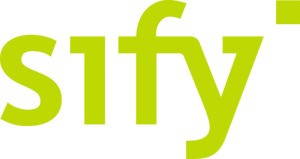
Determining the fastest Content Delivery Network (CDN) can be subjective and depends on various factors such as geographical location, network infrastructure, website optimization, and the specific content being delivered. However, several CDNs are renowned for their speed and reliability. Here are some of the top contenders:
Akamai: Akamai is one of the oldest and most established CDNs, with a vast global network of servers strategically distributed around the world. It offers advanced caching, acceleration, and security features, making it a popular choice for delivering high-performance content.
Cloudflare: Cloudflare operates one of the largest CDN networks globally, known for its robust performance and security features. It utilizes advanced technologies such as Anycast routing and edge computing to optimize content delivery and minimize latency.
Amazon CloudFront: Part of Amazon Web Services (AWS), CloudFront is a highly scalable CDN that integrates seamlessly with other AWS services. It offers low latency and high transfer speeds by leveraging Amazon's extensive global infrastructure.
Fastly: Fastly is a CDN designed for high-performance content delivery, particularly suited for delivering dynamic content and streaming media. Its edge cloud platform is known for its real-time caching and instant purging capabilities, resulting in fast and reliable content delivery.
CDN77: CDN77 is a global CDN provider known for its high-performance content delivery and competitive pricing. It offers a wide range of features, including HTTP/2 support, GZIP compression, and real-time analytics, making it a popular choice for businesses of all sizes.
Limelight Networks: Limelight Networks operates a global CDN optimized for delivering digital content, live and on-demand video streaming, and large file downloads. It boasts a high-performance infrastructure with extensive reach and low latency.
StackPath: StackPath offers a secure CDN with advanced caching and acceleration capabilities. It provides a user-friendly interface and flexible pricing options, making it suitable for businesses seeking reliable content delivery solutions.
It's essential to evaluate CDN performance based on your specific requirements, including geographic reach, traffic volume, content type, and budget constraints. Additionally, conducting performance tests and benchmarking different CDNs in your target regions can help determine which CDN offers the best speed and reliability for your website or application.
"Checkout IDC Whitepaper on Cloud https://www.sifytechnologies.com/cloud-services/#idc
0 notes
Photo
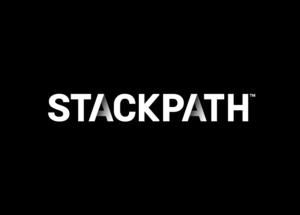
Get the Edge on Your Competition with Edge Computing by Stackpath
0 notes
Text
Recent Trends With IoT Edge Computing Software Market Analysis And Forecast 2028 Top Players Like | AWS, Azure IoT Edge, Rancher
The recent research report on the Global IoT Edge Computing Software Market 2022-2028 explains current market trends, possible growth rate, differentiable industry strategies, future prospects, significant players and their profiles, regional analysis, and industry shares as well as forecast details. The detail study offers a wide range of considerable information that also highlights the importance of the foremost parameters of the world IoT Edge Computing Software market.
Market Is Expected to Reach Rise At A CAGR Of 38% During The Forecast Period
(Exclusive Offer: Flat 30% discount on this report)
Click Here to Get Free Sample PDF Copy of Latest Research on IoT Edge Computing Software Market 2022 Before Purchase:
https://www.theresearchinsights.com/request_sample.php?id=489244&mode=V004
Top Key Players are covered in this report:
AWS, Azure IoT Edge, Rancher, Akamai, Check Point, NETSCOUT, Bosch, ClearBlade, Crosser, EdgeIQ, Google, IBM, IoT-Ignite, Software AG, StackPath, FogHorn, SAS, Nutanix
On the Basis of Product, the IoT Edge Computing Software Market Is Primarily Split Into
· Cloud-based
· On-premises
On the Basis of End Users/Application, This Report Covers
· Large Enterprises
· SMEs
·
The regions are further sub-divided into:
-North America (NA) – US, Canada, and Mexico
-Europe (EU) – UK, Germany, France, Italy, Russia, Spain & Rest of Europe
-Asia-Pacific (APAC) – China, India, Japan, South Korea, Australia & Rest of APAC
-Latin America (LA) – Brazil, Argentina, Peru, Chile & Rest of Latin America
-The Middle East and Africa (MEA) – Saudi Arabia, UAE, Israel, South Africa
Major Highlights of the IoT Edge Computing Software Market report study:
· A detailed look at the global IoT Edge Computing Software Industry
· The report analyzes the global IoT Edge Computing Software market and provides its stakeholders with significant actionable insights
· The report has considered all the major developments in the recent past, helping the users of the report with recent industry updates
· The report study is expected to help the key decision-makers in the industry to assist them in the decision-making process
· The study includes data on IoT Edge Computing Software market intelligence, changing market dynamics, current and expected market trends, etc.
· The report comprises an in-depth analysis of macroeconomic and microeconomic factors affecting the global IoT Edge Computing Software market
· Market Ecosystem and adoption across market regions
· Major trends shaping the global IoT Edge Computing Software market
· Historical and forecast size of the IoT Edge Computing Software market in terms of Revenue (USD Million)
SPECIAL OFFER: AVAIL UP TO 30% DISCOUNT ON THIS REPORT:
https://www.theresearchinsights.com/ask_for_discount.php?id=489244&mode=V004
Market Segment Analysis:
The IoT Edge Computing Software Report provides a primary review of the industry along with definitions, classifications, and enterprise chain shape. Market analysis is furnished for the worldwide markets which include improvement tendencies, hostile view evaluation, and key regions development. Development policies and plans are discussed in addition to manufacturing strategies and fee systems are also analyzed. This file additionally states import/export consumption, supply and demand, charge, sales and gross margins.
Browse Full Report at:
https://www.theresearchinsights.com/reports/global-iot-edge-computing-software-market-growth-2022-2028-489244?mode=V004
The Research covers the following objectives:
– To study and analyze the Global IoT Edge Computing Software consumption by key regions/countries, product type and application, history data from 2016 to 2022, and forecast to 2026.
– To understand the structure of IoT Edge Computing Software by identifying its various sub-segments.
– Focuses on the key global IoT Edge Computing Software manufacturers, to define, describe and analyze the sales volume, value, market share, market competition landscape, Porter’s five forces analysis, SWOT analysis and development plans in the next few years.
– To analyze the IoT Edge Computing Software with respect to individual growth trends, future prospects, and their contribution to the total market.
– To share detailed information about the key factors influencing the growth of the market (growth potential, opportunities, drivers, industry-specific challenges and risks).
– To project the consumption of IoT Edge Computing Software submarkets, with respect to key regions (along with their respective key countries).
Report Customization:
IoT Edge Computing Software, the report can be customized according to your business requirements as we recognize what our clients want, we have extended 25% customization at no additional cost to all our clients for any of our syndicated reports.
In addition to customization of our reports, we also offer fully tailored research solutions to our clients in all industries we track.
Our research and insights help our clients in identifying compatible business partners.
Note: All of the reports that we list have been tracking the impact of COVID-19 on the market. In doing this, both the upstream and downstream flow of the entire supply chain has been taken into account. In addition, where possible we will provide an additional COVID-19 update report/supplement to the report in Q3, please check with the sales team.
About us:
The Research Insights – A world leader in analysis, research and consulting that can help you renew your business and change your approach. With us you will learn to make decisions with fearlessness. We make sense of inconveniences, opportunities, circumstances, estimates and information using our experienced skills and verified methodologies. Our research reports will provide you with an exceptional experience of innovative solutions and results. We have effectively led companies around the world with our market research reports and are in an excellent position to lead digital transformations. Therefore, we create greater value for clients by presenting advanced opportunities in the global market.
Contact Us:
Robin
Sales Manager
Contact number: + 91-996-067-0000
https://www.theresearchinsights.com
0 notes
Text
Global Content Delivery Networks Market Outlook, Prospect and Future 2020-2026
Summary - A new market study, titled “Content Delivery Networks: Global Markets”has been featured on WiseGuyReports.
Content delivery networks (CDNs) are a group of edge servers that are spread across the globe at strategic locations. These severs accelerate websites and deliver content/data optimally, quickly and safely. The edge servers of a CDN contain duplicate content of the originating network. CDNs dynamically provide data to clients by calculating which server is located close to the client and content is delivered based on these calculations.
The global market for CDNs was valued at REDACTED billion in 2018 and is forecast to reach REDACTED billion by 2024 growing at a CAGR of REDACTED during the forecast period. CDNs were previously considered applicable only to large companies because of their high cost. Over the last few years, due to the changing form and trends of digital content, smaller companies are deploying these solutions. Currentday CDNs are more efficient, cheaper and have the capability to work for almost all websites on the internet.
Also Read: https://www.newsmaker.com.au/news/379223/content-delivery-networks-cdns-market-2020-global-analysis-share-trends-application-analysis-and-forecast-to-2024#.X2nOH6BR3IU
In this report, the global CDN market is segmented by solution type, service provider type, organization size and application. Based on solution type, the CDN market is segmented into media delivery, web performance optimization, monitoring and analytics, data security and cloud storage and others. The media delivery solutions segment accounted for the largest share of the market in 2018 and is expected to maintain dominance over the forecast period. The media delivery solution segment has been flourishing in the CDN market as video transport moves from specialized cable, satellite or terrestrial networks to the internet. Also, rise in internet video services such as Netflix, Hulu, Amazon and others
have largely contributed to the growth of the media delivery solutions segment in the CDN market. The fastest growing solution segment in the CDN market is the data security and cloud storage segment, which is expected to grow at a CAGR of REDACTED during the forecast period.
The global CDN market segmented by service provider type is categorized into peer-to-peer CDN, cloud CDN, traditional CDN and others. Traditional CDNs accounted for the largest share of the market in 2018 (valued at REDACTED billion). The market for traditional CDN is expected to grow at a CAGR of REDACTED and is forecast to reach REDACTED billion by 2024. Traditional CDNs are content delivery networks wherein the datais duplicated across multiple PoPs. Based on user location, the PoP located closest to the user willdeliver the page to reduce latency. The fastest growing category by serviceprovider type is the cloudCDN segment, which is expected to grow at a CAGR of REDACTED and is forecast to reach REDACTED billion by 2024, up from REDACTED billion in 2018. Cloud CDNs, unlike traditional CDNs, are hosted in private datacenters and take advantage of geographic availability on the pay-as-you-go model.
The CDN market by application is categorized into: banking, finance and insurance (BFSI), media and entertainment, gaming, retail and e-commerce and others. The media and entertainment segment accounted for the largest share of the market in 2018 and was estimated to be $4.0 billion. CDNs for the media and entertainment segment are expected to grow at a CAGR of REDACTED and forecasted to reach REDACTED billion by 2024. CDNs in the media and entertainment sector, improve network traffic and enable companies to deliver content to a large number of users, simultaneously. The fastest growing application segment in the CDN market is the gaming sector, which is expected to grow at a CAGR of REDACTED and is projected to reach REDACTED billion by 2024. Increasing global demand for online multi-player gaming and demand for content protection is driving the demand for CDNs in the gaming sector.Report Scope:
In this report, the market has been segmented based on solutions, service provider type, organization size, applications and geography. The report provides an overview of the global market for CDNs and analyzes market trends. Using 2018 as the base year, the report provides estimated market data for the forecast period 2019-2024. Revenue forecasts for this period are segmented based on solution type, service provider type, organization size and applications and geography. Market values have been estimated based on the total revenue of CDN providers.
The report covers the market for CDNs with regard to applications in various sectors across different geographic regions. It also focusses on the major trends and challenges that affect the market and the vendor landscape. The report estimates the global market for CDNs in 2018 and provides projections of the expected market size through 2024.
Report Includes:
- 49 data tables and 41 additional tables
- An overview of global content delivery network market
- Analyses of global market trends, with data from 2018, estimates of 2019, and projections of compound annual growth rates (CAGRs) through 2024
- Characterization and quantification of content delivery network market by solution, by service provider, by organization size and by application
- Identification of market drivers, restraints and other forces impacting the global content delivery network market
- Details about various solutions of content delivery networks in different application sectors
- Company profiles of leading market participants within the industry, including Alphabet Inc., Amazon.com, Inc., Cloudflare, Inc., Equinix, Inc., Imperva, Microsoft Corp., StackPath, LLC and Swarmify Inc.AKAMAI TECHNOLOGIES
ALPHABET INC. (GOOGLE INC.)
AMAZON WEB SERVICES (AMAZON.COM, INC.)
CDNETWORKS. INC.
CENTURYLINK, INC. (LEVEL 3 COMMUNICATIONS LLC)
CHINACACHE INTERNATIONAL HOLDINGS LTD.
CHINANETCENTER CO.
CLOUDFLARE, INC.
COMCAST TECHNOLOGY SOLUTIONS
EQUINIX, INC.
IMPERVA
LIMELIGHT NETWORKS, INC.
MICROSOFT CORP.
NETSTAIRS, INC.
RACKSPACE US, INC.
SCIENTIAMOBILE, INC.
STACKPATH, LLC
SWARMIFY, INC.
TOTAL SERVER SOLUTIONS
VARNISH SOFTWARE AB
VECIMA NETWORKS (CONCURRENT COMPUTER CORP.
FOR MORE DETAILS: https://www.wiseguyreports.com/reports/4497753-content-delivery-networks-global-markets
About Us:
Wise Guy Reports is part of the Wise Guy Research Consultants Pvt. Ltd. and offers premium progressive statistical surveying, market research reports, analysis & forecast data for industries and governments around the globe.
Contact Us:
NORAH TRENT
Ph: +162-825-80070 (US)
Ph: +44 203 500 2763 (UK)
0 notes
Photo

StackPath Partners Broadcom to Deliver Cloud-based Content-delivery Services via Edge Computing https://bit.ly/3bqn8kh
0 notes
Text
Zuora Central Platform Powers StackPath’s New Edge Computing-as-a-Service

Workflow Capabilities Save StackPath Over 120 Hours Each Month
SAN MATEO, Calif.–(BUSINESS WIRE)–Zuora, Inc., (NYSE:ZUO) the leading cloud-based subscription management platform provider, announced today that its customer, StackPath, launched a first of its kind edge computing platform, powered by the Zuora® Central platform, to enable the $200 billion hardware-as-a-service market. Zuora…
View On WordPress
0 notes
Link
via medium.com
Fastly S-1 Analysis — Accelerating the Edge
Around this time last year we saw the first DevOps company IPO, Pivotal. Now developers’ voices are being heard at the edge with Fastly’s $100M S-1 filing, with the amount as a placeholder. Fastly offers an edge cloud platform that enables developers to build, secure, and deliver digital experiences. The solution helps business serve dynamic, time-sensitive content quickly at an average of 150 milliseconds or less. Fastly not only helps business in mobile, gaming, and live-streaming but also new segments like IoT and AR/VR. In CY18 Fastly had 1.6K customers generating $144.6M in revenue. Founded in March 2011, Fastly has ~450 employees and is headquartered in San Francisco, CA.
Fastly’s products support the growing trend of moving compute power and logic as close to the end user as possible. The business defines its service as an “edge cloud,” a new category of IaaS that represents the convergence of CDN, ADC, WAF, Bot Detection, and DDoS solutions. It leverages serverless computing to run servers and dynamically manage the allocation of machine resources.
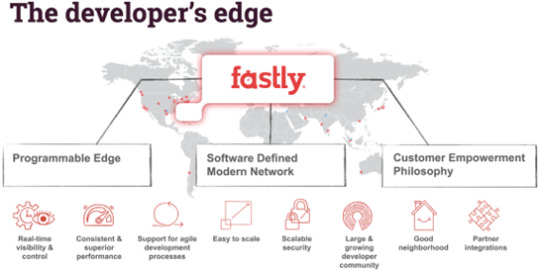
Its edge cloud platform consists of three key components: 1) a programmable edge, 2) a software-defined modern network, and 3) a philosophy of customer empowerment. The programmable edge sits between Fastly’s customers and their end users. Developers can write and deploy their code to push application logic to the edge. Fastly also offers reusable modules to developers. Developers can apply agile development practices like CI/CD. Fastly offers real-time visibility and control by streaming log data from the network edge, which helps developer make configuration changes, roll back deploys, and change code. There is also a serverless development environment.
Second, Fastly developed its software-defined modern network from the ground up. Fastly’s proprietary software runs on custom-designed servers built with commodity components and network hardware. The custom network stack includes built-in routing and load balancing, which Fastly claims improves performance, efficiency, and flexibility. Its 45 terabit edge network is located in 60 uniquely designed points-of-presence (POPs) across 21 countries as of March 31, 2019. This compares to Akamai’s ~2K pops across 139 countries and Cloudflare’s 175 POPS across ~80 countries. Fastly argues that it runs smaller clusters of more powerful servers using high-end CPUs, RAM, and SSDs for superior performance and 25 Gigabit Ethernet for robust bandwidth. Finally, its SDN is one network and can scale to defend against DDoS attacks.
The third leg is customer empowerment. Its free trial allows developers to sign up and start experimenting in a self-service manager. It also has rich documentation, a developer community, and a partner ecosystem.
Fastly argued legacy CDN’s are inferior because they are black box solutions with too many small servers that are capex intensive, exhibit latency, and haven’t integrated acquisitions into the core network. It underscored the heavy professional services business model was outdated.
Fastly addresses multiple markets including delivery, streaming, cloud security, and application delivery control. In aggregate Fastly’s Total Addressable Market (TAM) represents $18B in 2019 and is expect to grow to $35.8B in 2022, a 25.6% CAGR.
There are numerous competitors across CDNs, cloud providers, and data center providers. Direct CDN competitors include Akamai, Limelight, EdgeCast (part of Verizon Digital Media), Level3, Imperva, Cloudflare, InStart, StackPath, and Section.io. Cloud providers offer compute functionality at the edge like Amazon’s CloudFront, AWS Lambda, and Google Cloud Platform. Traditional load balancing, WAF, and DDoS competitors include F5, Citrix, A10 Networks, Cisco, Imperva, Radware, and Arbor Networks.
Fastly is growing well achieving $144.5M in CY18 compared to $105M in CY17, 38% YoY growth. In CY18 platform services represented 95% of revenue while the other 5% was other products, support, and professional services.
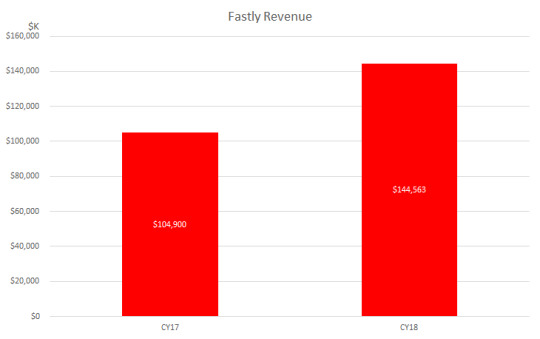
The U.S. represents the highest portion of revenue at 77% in CY18. In CY18 revenue expanded faster outside the U.S. than within. Total customer count grew 10% YoY and customer growth outside the U.S. outpaced domestic growth, at 18% and 4%, respectively.
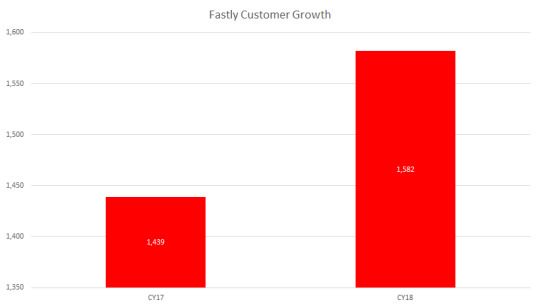
Importantly, Fastly has significant customer concentration with its 10 largest customers generating 32% of CY18 revenue. The number of “enterprise customers,” those who spend over $100K annually, increased from 170 in CY17 to 227 in CY18, up 33% YoY. The 227 enterprise customers represented 84% of total revenue in CY18. The average revenue across all enterprise customers was $530K in CY18.
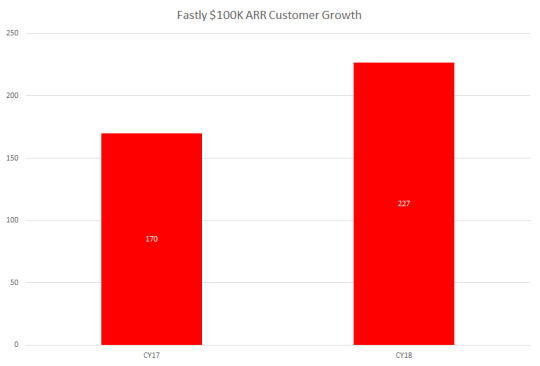
Fastly primarily generates revenue from usage-based fees for its platform. Some products and services have flat fees. Larger customers often enter into contracts that contain minimum billing commitments and reflect discounted pricing.
We thought it was interesting that Fastly emphasized a large part of its growth depends on the success of its partner relationships like Datadog, Looker, Heroku, Magento, Drupal, and Wordpress.
One thing that stood out to us was the business’ sound dollar-based net retention rate of 132% for CY18. The dollar-based net retention rate (NRR) is total current period ARR divided by the total prior period ARR for the customer cohort. Our recent research found that the top quartile of SaaS businesses observe net dollar retention of 120%+. Fastly’s 132% dollar-based net retention rate is good but below fellow developer-centric, recently IPOed PagerDuty’s 139%.

Moving on to gross margin, which equals revenue minus the cost of goods sold that includes things like hosting costs and customer support. Fastly achieved an 55% gross margin in CY18 below Akamai’s 65% in CY18.
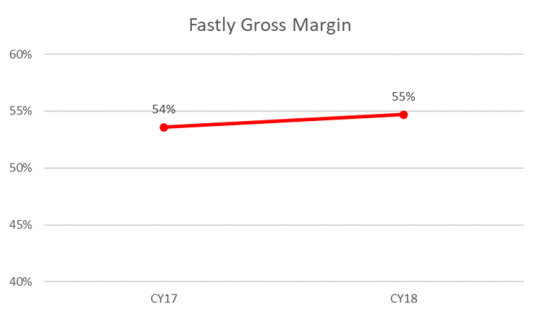
Of each operating expense item, Fastly spends the most on S&M at 35%. Fastly has a sales efficiency coefficient of 0.60. As a reminder, the sales efficiency coefficient measures gross profit increase over a period divided by sales & marketing investment. The company has an incredibly strong magic number of 1.2. A magic number of over 1.0 the business paid back its customer acquisition costs in a one-year timeframe.
In terms of net income margin, Fastly was -21% in CY18, an improvement from -31% for the equivalent period a year earlier.
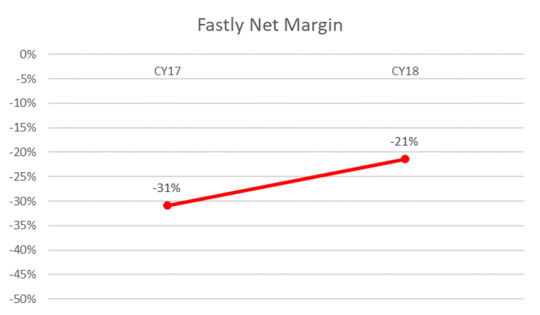
In July 2018, Fastly achieved a $935M valuation when it closed a $40M Series F financing led by Deutsche Telekom Capital partners. Fastly has raised $219M in funding from investors including Battery, August, ICONIQ, Amplify, and O’Reilly AlphaTech.
Fastly’s IPO registration touches on a few trends: 1) hyper-connected end-users are increasingly impatient, 2) advanced mobile applications like IoT, AR/VR, and live streaming, and 3) developers are the new decision-makers. With good revenue and customer growth, and strong net dollar retention, it will be exciting to watch as Fastly goes public.
Fastly S-1 Analysis — Accelerating the Edge was originally published in Memory Leak on Medium, where people are continuing the conversation by highlighting and responding to this story.
0 notes
Text
Fastly, the content delivery network, files for an IPO
Fastly, the content delivery network that’s raised $219 million in financing from investors (according to Crunchbase), is ready for its close up in the public markets.
The eight-year-old company is one of several businesses that improve the download time and delivery of different websites to internet browsers and it has just filed for an IPO.
Media companies like The New York Times use Fastly to cache their homepages, media and articles on Fastly’s servers so that when somebody wants to browse the Times online, Fastly’s servers can send it directly to the browser. In some cases, Fastly serves up to 90 percent of browser requests.
E-commerce companies like Stripe and Ticketmaster are also big users of the service. They appreciate Fastly because its network of servers enable faster load times — sometimes as quickly as 20 or 30 milliseconds, according to the company.
The company raised its last round of financing roughly nine months ago, a $40 million investment that Fastly said would be the last before a public offering.
Fastly raises another $40 million before an IPO
True to its word, the company is hoping public markets have the appetite to feast on yet another “unicorn” business.
While Fastly lacks the sizzle of companies like Zoom, Pinterest or Lyft, its technology enables a huge portion of the activities in which consumers engage online, and it could be a bellwether for competitors like Cloudflare, which recently raised $150 million and was also exploring a public listing.
The company’s public filing has a placeholder amount of $100 million, but given the amount of funding the company has received, it’s far more likely to seek closer to $1 billion when it finally prices its shares.
Fastly reported revenue of roughly $145 million in 2018, compared to $105 million in 2017, and its losses declined year on year to $29 million, down from $31 million in the year-ago period. So its losses are shrinking, its revenue is growing (albeit slowly) and its cost of revenues are rising from $46 million to around $65 million over the same period.
That’s not a great number for the company, but it’s offset by the amount of money that the company’s getting from its customers. Fastly breaks out that number in its dollar-based net expansion rate figure, which grew 132 percent in 2018.
It’s an encouraging number, but as the company notes in its prospectus, it’s got an increasing number of challenges from new and legacy vendors in the content delivery network space.
The market for cloud computing platforms, particularly enterprise-grade products, “is highly fragmented, competitive and constantly evolving,” the company said in its prospectus. “With the introduction of new technologies and market entrants, we expect that the competitive environment in which we compete will remain intense going forward. Legacy CDNs, such as Akamai, Limelight, EdgeCast (part of Verizon Digital Media), Level3, and Imperva, and small business-focused CDNs, such as Cloudflare, InStart, StackPath, and Section.io, offer products that compete with ours. We also compete with cloud providers who are starting to offer compute functionality at the edge like Amazon’s CloudFront, AWS Lambda, and Google Cloud Platform.”
0 notes
Text
Content Delivery Networks: Global Markets Research Report 2020-2025
Summary – A new market study, titled "Content Delivery Networks: Global Markets" has been featured on WiseGuyReports.
Summary
Content delivery networks (CDNs) are a group of edge servers that are spread across the globe at strategic locations. These severs accelerate websites and deliver content/data optimally, quickly and safely. The edge servers of a CDN contain duplicate content of the originating network. CDNs dynamically provide data to clients by calculating which server is located close to the client and content is delivered based on these calculations.
Also read – https://www.newsmaker.com.au/news/379223/content-delivery-networks-cdns-market-2020-global-analysis-share-trends-application-analysis-and-forecast-to-2024#.X2nOH6BR3IU
The global market for CDNs was valued at REDACTED billion in 2018 and is forecast to reach REDACTED billion by 2024 growing at a CAGR of REDACTED during the forecast period. CDNs were previously considered applicable only to large companies because of their high cost. Over the last few years, due to the changing form and trends of digital content, smaller companies are deploying these solutions. Currentday CDNs are more efficient, cheaper and have the capability to work for almost all websites on the internet.
In this report, the global CDN market is segmented by solution type, service provider type, organization size and application. Based on solution type, the CDN market is segmented into media delivery, web performance optimization, monitoring and analytics, data security and cloud storage and others. The media delivery solutions segment accounted for the largest share of the market in 2018 and is expected to maintain dominance over the forecast period. The media delivery solution segment has been flourishing in the CDN market as video transport moves from specialized cable, satellite or terrestrial networks to the internet. Also, rise in internet video services such as Netflix, Hulu, Amazon and others
have largely contributed to the growth of the media delivery solutions segment in the CDN market. The fastest growing solution segment in the CDN market is the data security and cloud storage segment, which is expected to grow at a CAGR of REDACTED during the forecast period.
The global CDN market segmented by service provider type is categorized into peer-to-peer CDN, cloud CDN, traditional CDN and others. Traditional CDNs accounted for the largest share of the market in 2018 (valued at REDACTED billion). The market for traditional CDN is expected to grow at a CAGR of REDACTED and is forecast to reach REDACTED billion by 2024. Traditional CDNs are content delivery networks wherein the datais duplicated across multiple PoPs. Based on user location, the PoP located closest to the user willdeliver the page to reduce latency. The fastest growing category by serviceprovider type is the cloudCDN segment, which is expected to grow at a CAGR of REDACTED and is forecast to reach REDACTED billion by 2024, up from REDACTED billion in 2018. Cloud CDNs, unlike traditional CDNs, are hosted in private datacenters and take advantage of geographic availability on the pay-as-you-go model.
The CDN market by application is categorized into: banking, finance and insurance (BFSI), media and entertainment, gaming, retail and e-commerce and others. The media and entertainment segment accounted for the largest share of the market in 2018 and was estimated to be $4.0 billion. CDNs for the media and entertainment segment are expected to grow at a CAGR of REDACTED and forecasted to reach REDACTED billion by 2024. CDNs in the media and entertainment sector, improve network traffic and enable companies to deliver content to a large number of users, simultaneously. The fastest growing application segment in the CDN market is the gaming sector, which is expected to grow at a CAGR of REDACTED and is projected to reach REDACTED billion by 2024. Increasing global demand for online multi-player gaming and demand for content protection is driving the demand for CDNs in the gaming sector.Report Scope:
In this report, the market has been segmented based on solutions, service provider type, organization size, applications and geography. The report provides an overview of the global market for CDNs and analyzes market trends. Using 2018 as the base year, the report provides estimated market data for the forecast period 2019-2024. Revenue forecasts for this period are segmented based on solution type, service provider type, organization size and applications and geography. Market values have been estimated based on the total revenue of CDN providers.
The report covers the market for CDNs with regard to applications in various sectors across different geographic regions. It also focusses on the major trends and challenges that affect the market and the vendor landscape. The report estimates the global market for CDNs in 2018 and provides projections of the expected market size through 2024.
Report Includes:
- 49 data tables and 41 additional tables
- An overview of global content delivery network market
- Analyses of global market trends, with data from 2018, estimates of 2019, and projections of compound annual growth rates (CAGRs) through 2024
- Characterization and quantification of content delivery network market by solution, by service provider, by organization size and by application
- Identification of market drivers, restraints and other forces impacting the global content delivery network market
- Details about various solutions of content delivery networks in different application sectors
- Company profiles of leading market participants within the industry, including Alphabet Inc., Amazon.com, Inc., Cloudflare, Inc., Equinix, Inc., Imperva, Microsoft Corp., StackPath, LLC and Swarmify Inc.AKAMAI TECHNOLOGIES
ALPHABET INC. (GOOGLE INC.)
AMAZON WEB SERVICES (AMAZON.COM, INC.)
CDNETWORKS. INC.
CENTURYLINK, INC. (LEVEL 3 COMMUNICATIONS LLC)
CHINACACHE INTERNATIONAL HOLDINGS LTD.
CHINANETCENTER CO.
CLOUDFLARE, INC.
COMCAST TECHNOLOGY SOLUTIONS
EQUINIX, INC.
IMPERVA
LIMELIGHT NETWORKS, INC.
MICROSOFT CORP.
NETSTAIRS, INC.
RACKSPACE US, INC.
SCIENTIAMOBILE, INC.
STACKPATH, LLC
SWARMIFY, INC.
TOTAL SERVER SOLUTIONS
VARNISH SOFTWARE AB
VECIMA NETWORKS (CONCURRENT COMPUTER CORP.)
For more details - https://www.wiseguyreports.com/reports/4497753-content-delivery-networks-global-markets
About Us:
Wise Guy Reports is part of the Wise Guy Research Consultants Pvt. Ltd. and offers premium progressive statistical surveying, market research reports, analysis & forecast data for industries and governments around the globe.
Contact Us:
NORAH TRENT
Ph: +162-825-80070 (US)
Ph: +44 2035002763 (UK)
0 notes
Link
Edge Computing has arrived at StackPath with the announcement of the availability of Edge Containers and Edge VMs (virtual machines). When we launched our serverless scripting product, EdgeEngine, the goal was to allow low latency execution of complex logic as close to the user as possible.
0 notes